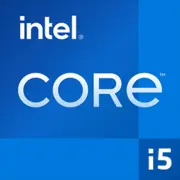Intel Core i5-10400

Intel Core i5-10400: Comprehensive Review of the Budget Processor of 2025
April 2025
1. Key Specifications: Architecture, Performance, and Key Features
Codename and Manufacturing Process
The Intel Core i5-10400 processor, released in 2020, is based on the Comet Lake architecture and manufactured using a 14nm process. Although by 2025 this process is considered outdated (new chips are using 7-10nm), the i5-10400 remains relevant due to its low price and balanced performance.
Cores, Threads, and Cache
- 6 cores and 12 threads thanks to Hyper-Threading.
- Base frequency: 2.9 GHz, max turbo frequency: 4.3 GHz.
- L3 cache: 12 MB — sufficient for handling moderate workloads.
Power Consumption and Graphics
- TDP 65W: low power consumption, suitable for compact builds.
- Integrated Intel UHD Graphics 630: handles office tasks, 4K video playback, and less demanding games (e.g., CS:GO on low settings).
Performance
- Geekbench 6: 1422 (Single-Core), 5460 (Multi-Core).
- In tests from 2025, the processor demonstrates:
- Smooth browsing with 20+ tabs open.
- Video rendering in 1080p (Premiere Pro) in an acceptable time (15-20 minutes for a 10-minute clip).
- Gaming on medium settings with a discrete graphics card (e.g., GTX 1660 Super).
Key Features
- Support for Intel Optane Memory to accelerate HDD performance.
- Turbo Boost 2.0 and Hyper-Threading technologies.
2. Compatible Motherboards: Sockets and Chipsets
LGA 1200 Socket
The processor requires motherboards with the LGA 1200 socket. Popular chipsets include:
- H410 / B460: budget options without overclocking (prices in 2025: $70-100).
- H470 / Z490: support for PCIe 3.0, more lanes for peripherals (Z490 allows overclocking for CPUs with the “K” index).
Selection Recommendations
- For office PCs: H410 (e.g., ASRock H410M-HDV).
- For home systems: B460 (MSI B460M-A Pro) — a balance of price and functionality.
- For upgrades: Z490 (Gigabyte Z490 UD) — a future-proof option if planning to install a more powerful CPU (e.g., i9-10900K).
Features
- On H410/B460 chipsets, memory frequency is limited to 2666 MHz.
- No support for PCIe 4.0 — this is critical only for high-end graphics cards (e.g., RTX 4080+).
3. Supported Memory Types
- DDR4-2666 MHz (on H410/B460) or DDR4-2933 MHz (on Z490).
- Maximum Capacity: 128 GB.
Recommendations
- Basic option: 16 GB (2x8 GB) DDR4-2666 — sufficient for gaming and multitasking.
- For work tasks: 32 GB DDR4-2666 (rendering, virtualization).
Limitations
- DDR5 not supported — keep this in mind when building a “future-proof” PC.
4. Power Supplies: Power Calculation
- Processor TDP: 65W.
- Recommended PSU wattages:
- Without a discrete graphics card: 300-400W.
- With a graphics card at the level of RTX 3060: 500-600W.
- For RTX 4070 and above: 650+W.
PSU Examples
- For budget builds: EVGA 500 BR (500W, 80+ Bronze, $50).
- For gaming PCs: Corsair CX650M (650W, 80+ Bronze, $80).
Tip: Don’t skimp on the PSU — low-quality models may cause system instability.
5. Pros and Cons of the Processor
Pros:
- Low price ($120-150 in 2025).
- Energy efficiency (suitable for compact cases).
- Good multi-threaded performance.
Cons:
- Outdated 14nm process.
- No support for PCIe 4.0 and DDR5.
- Overclocking limitations (only for “K” series models).
6. Use Cases
- Office Tasks: Working with documents, video conferencing, multitasking.
- Multimedia: 4K video streaming, editing home videos.
- Gaming: Comfortable performance with GTX 1660 Super or RX 6600 (60 FPS in Full HD in Cyberpunk 2077 on medium settings).
- Work Tasks: Programming, 3D modeling (Blender), rendering in resolutions up to 1080p.
Limitations: Not suitable for 4K gaming, professional 8K video editing, or neural network tasks.
7. Comparison with Competitors
AMD Ryzen 5 3600 ($130-150):
- Pros: 7nm process, larger cache (32MB), PCIe 4.0 support.
- Cons: Higher TDP (65W vs 95W), weaker in single-threaded tasks.
AMD Ryzen 5 5600G ($140-160):
- Pros: Integrated Vega 7 graphics (stronger than UHD 630), PCIe 4.0.
- Cons: Lower frequency in multi-threaded scenarios.
Conclusion: The i5-10400 excels in the budget segment if PCIe 4.0 is not required.
8. Practical Assembly Tips
- Cooling: The boxed cooler is sufficiently effective, but for quieter operation, consider the DeepCool GAMMAXX 400 ($25).
- Storage: Always use an SSD (e.g., Kingston A2000 500GB, $45) for the OS.
- Upgrade: The maximum CPU for LGA 1200 is the i9-10900K (10 cores).
- BIOS: Update the motherboard firmware for compatibility.
9. Final Thoughts: Who is the i5-10400 for?
This processor is an ideal choice for:
- Budget Builds: If the goal is to save money without sacrificing performance.
- Office and Home PCs: For work, study, and multimedia.
- Beginner Gamers: In conjunction with a graphics card like the RTX 3060.
Why in 2025? Despite its age, the i5-10400 remains a cost-effective option thanks to its low price and sufficient power for everyday tasks. However, for resource-intensive projects (AI, 4K rendering), it is better to choose more modern models.
Prices are current as of April 2025. All mentioned brands are registered trademarks.
Basic
CPU Specifications
Memory Specifications
GPU Specifications
Miscellaneous
Benchmarks
Compared to Other CPU
Share in social media
Or Link To Us
<a href="https://cputronic.com/cpu/intel-core-i5-10400" target="_blank">Intel Core i5-10400</a>